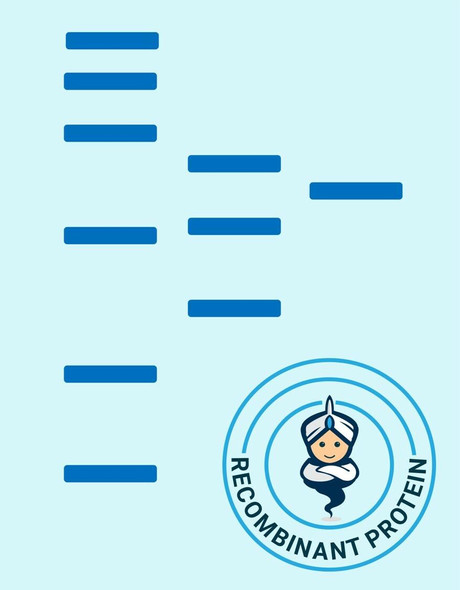Description
| Product Name: | Human POMC Recombinant Protein |
| Product Code: | RPPB4277 |
| Size: | 10µg |
| Species: | Human |
| Target: | POMC |
| Synonyms: | Pro-opiomelanocortin, POMC, LPH, MSH, NPP, POC, ACTH, CLIP. |
| Source: | Escherichia Coli |
| Physical Appearance: | Sterile Filtered colorless solution. |
| Formulation: | POMC protein solution (0.25mg/ml) containing 20mM Tris-HCl buffer (pH 8.0), 1mM DTT, 50% glycerol and 0.2M NaCl. |
| Stability: | Store at 4°C if entire vial will be used within 2-4 weeks. Store, frozen at -20°C for longer periods of time. For long term storage it is recommended to add a carrier protein (0.1% HSA or BSA).Avoid multiple freeze-thaw cycles. |
| Purity: | Greater than 85.0% as determined by SDS-PAGE. |
| Amino Acid Sequence: | MGSSHHHHHH SSGLVPRGSH MWCLESSQCQ DLTTESNLLE CIRACKPDLS AETPMFPGNG DEQPLTENPR KYVMGHFRWD RFGRRNSSSS GSSGAGQKRE DVSAGEDCGP LPEGGPEPRS DGAKPGPREG KRSYSMEHFR WGKPVGKKRR PVKVYPNGAE DESAEAFPLE FKRELTGQRL REGDGPDGPA DDGAGAQADL EHSLLVAAEK KDEGPYRMEH FRWGSPPKDK RYGGFMTSEK SQTPLVTLFK NAIIKNAYKK GE |
Pro-opiomelanocortin preproprotein (POMC) is a polypeptide hormone precursor which experiences extensive, tissue-specific, post-translational processing via cleavage by subtilisin-like enzymes known as prohormone convertases. POMC regulates the corticosteroid production in the adrenal cortex. Furthermore, POMC is cleaved into ten hormone chains named NPP, g-MSH, ACTH, a-MSH, CLIP, Lipotropin b, Lipotropin g, b-MSH,b endorphin and Met-enkephalin. POMC gene defects are the cause of POMC deficiency, which is characterized by red hair and adrenal insufficiency.
POMC produced in E.Coli is a single, non-glycosylated polypeptide chain containing 262 amino acids (27-267 a.a) and having a molecular mass of 28.9kDa (molecular weight on SDS-PAGE will appear higher).POMC is fused to a 21 amino acid His-tag at N-terminus & purified by proprietary chromatographic techniques.
| UniProt Protein Function: | POMC: ACTH stimulates the adrenal glands to release cortisol. Defects in POMC may be associated with susceptibility to obesity (OBESITY). It is a condition characterized by an increase of body weight beyond the limitation of skeletal and physical requirements, as the result of excessive accumulation of body fat. Defects in POMC are the cause of pro-opiomelanocortinin deficiency (POMCD). Affected individuals present early-onset obesity, adrenal insufficiency and red hair. Belongs to the POMC family. |
| UniProt Protein Details: | Protein type:Secreted, signal peptide; Secreted Chromosomal Location of Human Ortholog: 2p23.3 Cellular Component: peroxisomal matrix; extracellular space; cytoplasm; extracellular region; peroxisome; secretory granule Molecular Function:type 3 melanocortin receptor binding; G-protein-coupled receptor binding; type 4 melanocortin receptor binding; hormone activity; receptor binding Biological Process: generation of precursor metabolites and energy; cellular protein metabolic process; cell-cell signaling; neuropeptide signaling pathway; regulation of blood pressure; peptide hormone processing; regulation of appetite; positive regulation of transcription from RNA polymerase II promoter; negative regulation of tumor necrosis factor production; signal transduction; glucose homeostasis; cellular pigmentation Disease: Obesity; Proopiomelanocortin Deficiency |
| NCBI Summary: | This gene encodes a polypeptide hormone precursor that undergoes extensive, tissue-specific, post-translational processing via cleavage by subtilisin-like enzymes known as prohormone convertases. There are eight potential cleavage sites within the polypeptide precursor and, depending on tissue type and the available convertases, processing may yield as many as ten biologically active peptides involved in diverse cellular functions. The encoded protein is synthesized mainly in corticotroph cells of the anterior pituitary where four cleavage sites are used; adrenocorticotrophin, essential for normal steroidogenesis and the maintenance of normal adrenal weight, and lipotropin beta are the major end products. In other tissues, including the hypothalamus, placenta, and epithelium, all cleavage sites may be used, giving rise to peptides with roles in pain and energy homeostasis, melanocyte stimulation, and immune modulation. These include several distinct melanotropins, lipotropins, and endorphins that are contained within the adrenocorticotrophin and beta-lipotropin peptides. The antimicrobial melanotropin alpha peptide exhibits antibacterial and antifungal activity. Mutations in this gene have been associated with early onset obesity, adrenal insufficiency, and red hair pigmentation. Alternatively spliced transcript variants encoding the same protein have been described. [provided by RefSeq, Nov 2014] |
| UniProt Code: | P01189 |
| NCBI GenInfo Identifier: | 116880 |
| NCBI Gene ID: | 5443 |
| NCBI Accession: | P01189.2 |
| UniProt Secondary Accession: | P01189,P78442, Q53T23, Q9UD39, Q9UD40, |
| UniProt Related Accession: | P01189 |
| Molecular Weight: | 267 |
| NCBI Full Name: | Pro-opiomelanocortin |
| NCBI Synonym Full Names: | proopiomelanocortin |
| NCBI Official Symbol: | POMC�� |
| NCBI Official Synonym Symbols: | LPH; MSH; NPP; POC; ACTH; CLIP�� |
| NCBI Protein Information: | pro-opiomelanocortin; beta-LPH; beta-MSH; alpha-MSH; gamma-LPH; gamma-MSH; beta-endorphin; met-enkephalin; lipotropin beta; lipotropin gamma; melanotropin beta; melanotropin alpha; melanotropin gamma; pro-ACTH-endorphin; adrenocorticotropin; corticotropin-lipotropin; adrenocorticotropic hormone; opiomelanocortin prepropeptide; proopiomelanocortin preproprotein; beta-melanocyte-stimulating hormone; alpha-melanocyte-stimulating hormone; corticotropin-like intermediary peptide |
| UniProt Protein Name: | Pro-opiomelanocortin |
| UniProt Synonym Protein Names: | Corticotropin-lipotropinCleaved into the following 11 chains:NPP; Melanotropin gammaAlternative name(s):Gamma-MSH |
| Protein Family: | Pro-opiomelanocortin |
| UniProt Gene Name: | POMC�� |
| UniProt Entry Name: | COLI_HUMAN |






